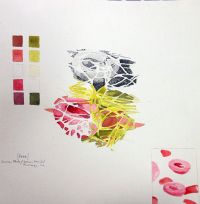| (28 intermediate revisions by 8 users not shown) | |||
| Line 36: | Line 36: | ||
==Literature== | ==Literature== | ||
* Dalston, Lorrain, Objectivity, Zone Books, 2007 | * Dalston, Lorrain, Objectivity, Zone Books, 2007 ISBN 978-1890951795 | ||
* Armstrong, Carol, Ocean Flowers, Impressions from Nature, Princeton University Press, 2004 | * Armstrong, Carol, Ocean Flowers, Impressions from Nature, Princeton University Press, 2004 ISBN 978-0691119489 | ||
* Schmidt-Bleek, Cornelia, creepers and climbers, Revolver - Archiv fuer aktuelle Kunst, 2006 | * Schmidt-Bleek, Cornelia, creepers and climbers, Revolver - Archiv fuer aktuelle Kunst, 2006 ISBN 978-3865882363 | ||
* Ingold, Tim, Lines. A Brief History, Routledge, 2007 | * Ingold, Tim, Lines. A Brief History, Routledge, 2007 ISBN 978-0415424271 | ||
==Works== | ==Works== | ||
* [[Adriana]] | |||
* [[/First Lesson/]] | |||
* [[/Second Lesson/]] | |||
* [[/Adriana/]] | |||
* [[/Wiebke/]] | |||
* [[/Lydia/]] | |||
* [[/Juliane/]] | |||
* [[/Laura/]] | |||
* [[/Monique/]] | |||
* [[/Anne/]] | |||
* [[/Maria/]] | |||
* [[/Tina/]] | |||
==Final Project== | |||
* [[/Adriana M/]] | |||
* [[/Wiebke J/]] | |||
*[[/Lydia Sophie/]] | |||
* [[/Laura J/]] | |||
* [[/Juliane B/]] | |||
==Links== | ==Links== | ||
Latest revision as of 17:18, 13 February 2013
Werkmodul/Fachmodul
Lecturer: Dominique Hurth
Credits: 6 ECTS, 4 SWS
Date: Tuesday, 13:30 until 16:45 h
Venue: Marienstraße 7b, Room 201
First meeting: 2012-10-16
Description
The act of drawing has been historically embedded in the development of natural-science, when technologies of representation and recording were not yet developed, accurate or easy to transport, and has since still been a predominant tool and device for any attempts of recording what the eyes see and illustrate mechanisms and organisms. Looking back at this technique, this practical module will question the cutting point between science and art, between the exact representation of nature and abstraction, by using as starting points the images viewed from the self-built microscope. In the moment of looking long and intently with affection at a subject and depicting it, what subjective desires of representation and new possibilities of perception do the drawing as an aesthetic tool achieve?
Course language will be English (except everyone speaks German then it will be in German.. obviously).
German description
Eingebettet in die Geschichte und Entwicklung der Naturwissenschaften, ist das Zeichnen nach wie vor ein wichtiges Instrument für das Festhalten dessen, was unsere Augen sehen und für die Darstellung von Mechanismen und Organismen. Diese Technik und Methode wird in diesem Modul praktisch mit dem Zeichnen von Mikroskopbildern erlernt und dabei die Schnittstelle von Wissenschaft und Kunst befragt, zwischen genauer Abbildung der Natur und Abstraktion. Welche subjektiven Darstellungswünsche und neuen Wahrnehmungsmöglichkeiten ermöglicht das Zeichnen als ästhetisches Tool in dem Moment des aufmerksamen Ansehens und Abbildens eines Subjektes?
Kurssprache ist Englisch (es sei denn alle Teilnehmer verstehen und sprechen Deutsch. Dann ist die Kurssprache natürlich Deutsch).
Topics
- Art
- Natural-History
- Art-History
- Perception
- Technology
Admission requirements
- none
Evaluation
Active participation, presentation, artistic examination, documentation, edits in the wiki.
Eligible participants
Undergraduates and graduates enrolled in the Faculties of Media and Gestaltung
Literature
- Dalston, Lorrain, Objectivity, Zone Books, 2007 ISBN 978-1890951795
- Armstrong, Carol, Ocean Flowers, Impressions from Nature, Princeton University Press, 2004 ISBN 978-0691119489
- Schmidt-Bleek, Cornelia, creepers and climbers, Revolver - Archiv fuer aktuelle Kunst, 2006 ISBN 978-3865882363
- Ingold, Tim, Lines. A Brief History, Routledge, 2007 ISBN 978-0415424271
